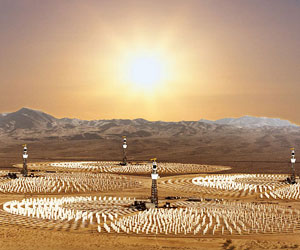Solar Reserve to move forward with massive Crossroads project
 Solar Reserve received its last required approval for its Crossroads Solar Energy Project in Arizona last week and should soon be able to begin construction.
Solar Reserve received its last required approval for its Crossroads Solar Energy Project in Arizona last week and should soon be able to begin construction.
The Maricopa County Board of Supervisors unanimously approved Solar Reserve’s conditional use permit for a combined 150-megawatt concentrated solar power and 65-megawatt solar photovoltaic installation that will be able to provide enough energy day and night to power 100,000 homes.
The project will still need construction authorizations, said Solar Reserve Vice President of Development Tom Georgis. But the county permit was the last major approval the company needed to move forward.
The biggest approval process was getting the county to amend its comprehensive plan in 2010 to rezone the land from rural to industrial use, Georgis said. It has also been through several environmental evaluations.
Solar Reserve expects to sell the energy the massive solar plant will produce to California. But Georgis said the company is still researching the logistics of doing that and negotiating transmission agreements.
“Crossroads has completed all of its interconnection studies and is negotiating a Large Generator Interconnection Agreement with Arizona Public Service, authorizing an upgrade of APS’ Panda 230 kV substation to accommodate the injection of new renewable power,” Georgis said. “We are investigating long-term firm transmission rights to Palo Verde substation, where the energy would be dynamically transferred or imported into the California ISO balancing authority.”
If it’s transmitted correctly into California, the renewable power would qualify under California’s Renewable Energy Portfolio Standard, which requires all California utilities to get 33 percent of their energy from renewable sources by 2020.
“The RPS has applied to investor owned utilities in the past but now publicly owned and municipal utilities are also subject to RPS compliance which has significantly increased the market opportunity,” Georgis said.
Solar is particularly competitive in California because of high energy demand and the portfolio standard. It’s a good market to sell in to, Georgis said.
Of course, Solar Reserve could easily sell its energy to Arizona utilities if transmission to California won’t work or make sense.
“Crossroads is ideally sited near APS transmission to provide clean energy to Arizona utilities,” Georgis said, “but it is flexible enough to alternately send its power to California should Arizona not need the energy.”
The massive project is just one of many Solar Reserve has in different stages of development across the southwestern United States. It’s also working on developing projects in the Middle East, Africa, Australia, Chile, Turkey and China.



